I enjoy the variety of getting different numbers of birds and varying backgrounds in my swan flight shots.
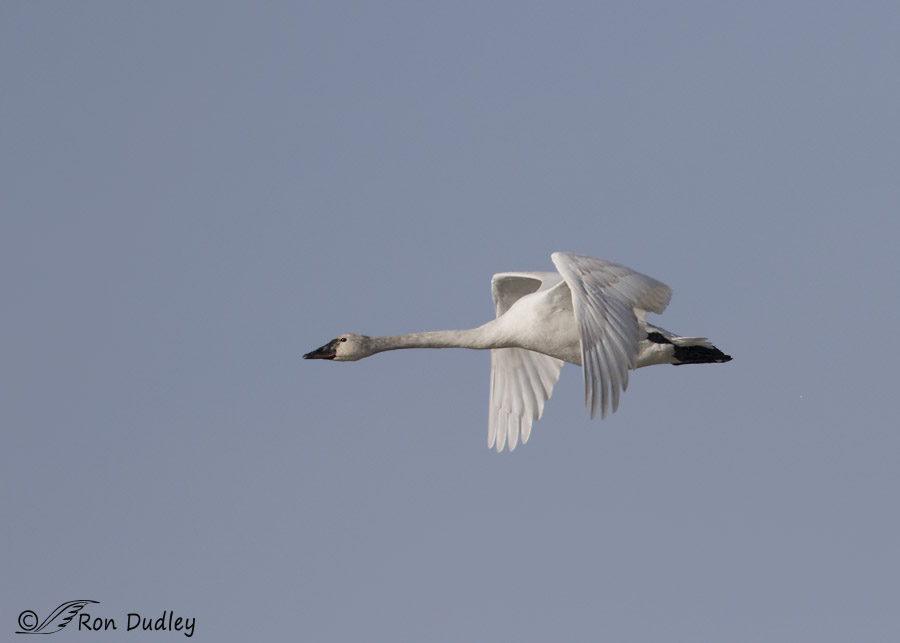
1/4000, f/7.1, ISO 500, Canon 7D Mark, Canon EF500mm f/4L IS USM +1.4x tc, not baited, set up or called in
Each of these first three images was taken a week ago (3/5/15) at Bear River MBR. A single bird in flight against a plain blue sky can be kind of blasé so for me an interesting wing position like this one can help to compensate.
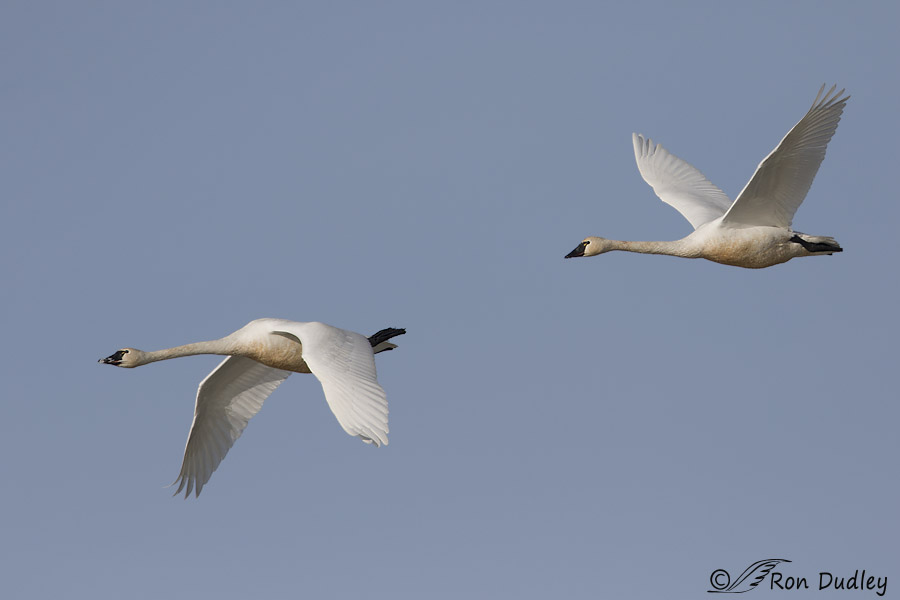
1/4000, f/7.1, ISO 500, Canon 7D Mark, Canon EF500mm f/4L IS USM +1.4x tc, not baited, set up or called in
Aesthetically I generally prefer to get an odd number of birds in the image but the more birds you have the more difficult it is to get interesting and varying wing positions without having parts of one swan in front of another. This image is full frame.
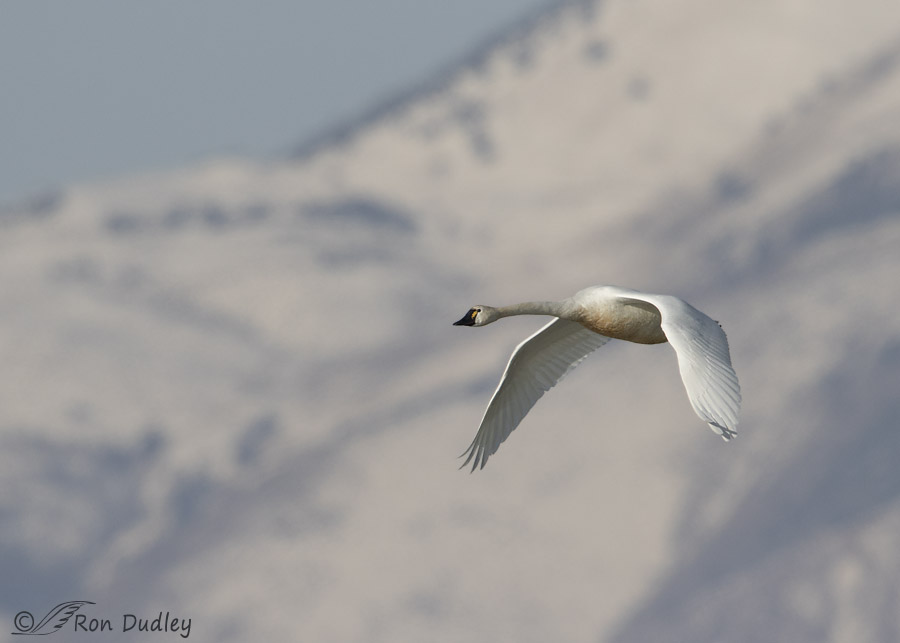
1/4000, f/7.1, ISO 500, Canon 7D Mark, Canon EF500mm f/4L IS USM +1.4x tc, not baited, set up or called in
In my area I’m sometimes lucky enough to get mountains in the background. For me doing so adds interest and context.
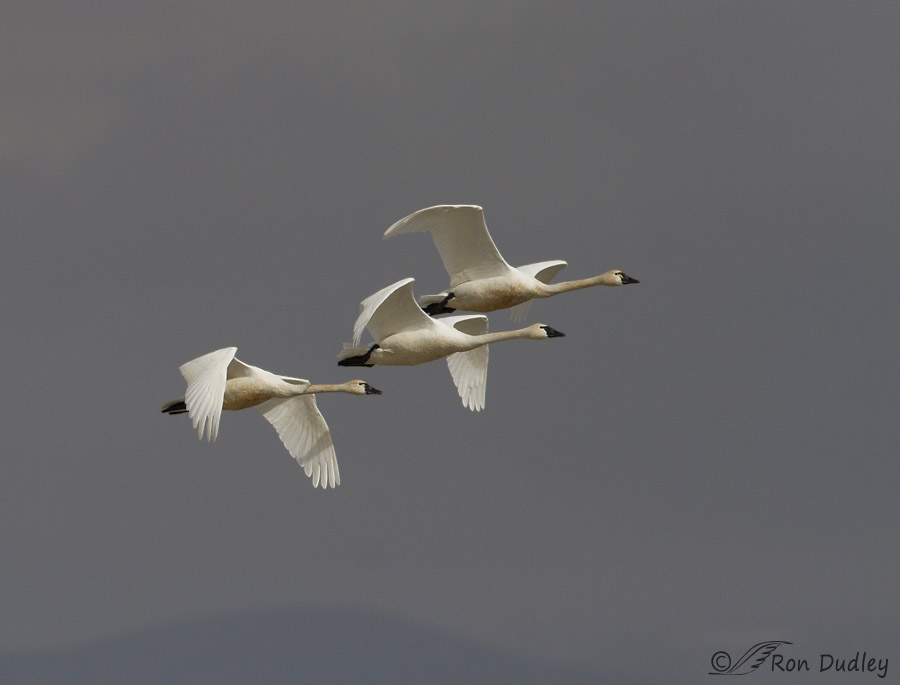 1/8000, f/7.1, ISO 640, Canon 7D, Canon EF500mm f/4L IS II USM +1.4 tc, not baited, set up or called in
1/8000, f/7.1, ISO 640, Canon 7D, Canon EF500mm f/4L IS II USM +1.4 tc, not baited, set up or called in
I took this shot exactly a year before the previous ones (3/5/14) and I decided to include it here because of the interesting lighting. The swans are in full sunlight with dark, foreboding skies in the background and I also have shaded mountains at the bottom of the frame.
I had a difficult time deciding how to frame this shot so in the end I chose to…
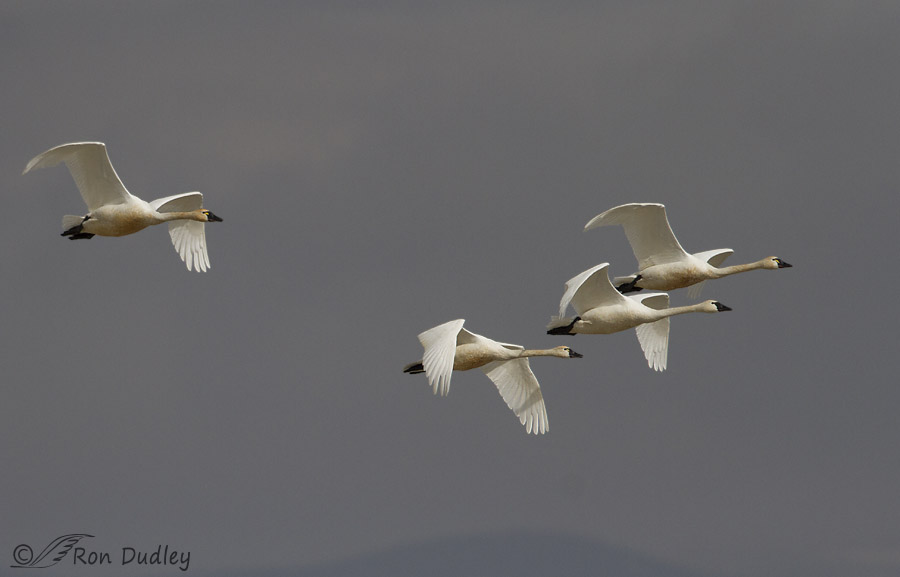
include two versions for your consideration. My preference leans toward this last one but I do vacillate…
Swan Day at Bear River MBR is March 14 (two days from now) and it should be a banner year for viewing them. Typically there’d be about 13,000 swans on the refuge this time of year but because of our warm winter with little ice more birds than usual have wintered here and the last count was roughly 21,000 birds. According to the U.S. Fish and Wildlife Service that’s easily a fourth of all the swans in the western U.S.
Even though they can be quite difficult to get close to, seeing (and hearing) that many swans at one time is quite the spectacle and I encourage those interested to make the effort to see them if at all possible.
After all, they won’t be here much longer.
Ron
Note: Photographers will likely ponder my high shutter speeds in these shots (especially the last one). Those settings were simply mistakes resulting from changing conditions, bright white birds, occasional dark backgrounds and lack of time to make adjustments. Excuses, excuses, I know…


GREAT WORK!
Hi! Beautiful birds and colors and them in flight is great!
Ron,
GREAT SHOTS! I was out at the refuge this morning and the swans are moving out fast. I guess that the warm weather not only kept them here
during the winter but also may be prompting them to move on sooner. Today I saw the least swans I have all winter. Still got some other species though.
The eagles seem to have moved on as well. A week ago the were still a bunch of eagles at SCWMA. Two days later we saw three to four and today just one.
That they bond and have feelings was driven home to me many years ago when one of a bonded pair was apparently killed. It was heart-wrenching to see and hear the plaintive calls of the one left as it flew around for several days searching and calling for its mate before finally flying off…
Interesting that you saw a pair of swans that were banded in 2010..so you know they’re at least 5 years old. Some years ago, we had a pair of swans nesting on a local reservoir. There were only those two and eveyone enjoyed seeing them. Some recent immigrant guy from the city killed them, planning to eat them, but was was quickly arrested. The community was outraged by the killing. This parently included the judge who sentenced him. He was sentenced to replace them with a bonded pair and guard them from all predators and harm for a full year. We now have several resident pairs and in the spring and fall have over a hundred….it’s a beautiful sight!
Beautiful!!
JUst lovely! For some reason, I resonate most strongly with the 5th photo with 4 tundra swans. I’m so glad you were there to witness that moment! As always, thanks.
Love them all – but am intrigued by the wing position in the first. I have spent a happy few minutes scrolling up and down, and up and down.
Thank you.
I’m delighted that you enjoyed the images so much, EC. Thank you.
I especially like the variety of wing positions in the fourth….these birds seem almost magically beautiful…
On revisiting (I always look at your pictures several times), I like the last two best…I usually prefer odd numbers, as in the third, but the last coposition is kind of “odd plus one”…I like the balance of it….
“the last composition is kind of “odd plus one”
Well said, Patty. I like your reasoning.
Ron, Beautiful shots indeed, the light with the foreboding sky is just wonderful. Do swans fly in V-formations as geese are inclined to do? If so I would prefer the the second of the two images as it infers the front of a V formation! If they do not fly typically in V-formation then the former of the two images. However, they are both superb with excellent DoF. Regards, William
William, yes, they typically do fly in V-formation, particularly during migration. Thank you.
Just to weigh in with an opinion, my husband and I both vote for the last picture with 4 swans. They are all amazing.
I always appreciate opinions, Michelle so thank you both for weighing in. Hope you’re doing well.
Beautiful shots of a beautiful bird. But for me, the white bird against white mountains doesn’t work. The blurriness of the mountains overwhelms the bird for my eyes, plus the similarity of color between the bird and the mountains makes it harder for my eyes to pick out the bird, even though the bird is very clear. I guess I’m happier with pictures where my eyes don’t have to fight to enjoy the subject. In this series, the photos with the clear skies allow me to enjoy the beauty of the birds. We’re all different, I guess.
I see your point, Susan and don’t disagree (though I still like the mountains back there for context. Thank you for your honest response!
Beautiful images of beautiful, stately birds!!! And NO DAMNED COLLARS!!!! All so beautiful I can’t even pick put a favorite…love composition and detail in all of them!!!
Patty, Actually, we did photograph two collared swans in flight. Those collar numbers were reported to the USGS Patuxent Wildlife Research Center Bird Banding Laboratory and it turns out that both birds were collared on July 28, 2010 in Northwest Arctic Borough, Alaska as adult birds. Both are females and they’re now at least 7 years old.
Interesting that they’re still together after this much distance and time (my flight shots show both birds in the frame just a couple of feet from each other).
They are so beautiful! What an awesome sight it must be to see so many swans together!!
It was, Leisa. Most of them were far out on the refuge but the sights and sounds were still amazing.
Sensational flight shots Ron! !
Charlotte
Thank you, Charlotte.
I like them both!
The first one for artistic, framed reasons, the second one, because that seems more natural, what I would see if I were looking up at them.
I remember well when I saw my first Life Tundra Swan in Yellowstone Nat.Prk., such a beautiful bird.
Thanks for the memories.
Dick, I saw my first one on a little creek on our Montana farm when I was a young kid. Made quite the impression on me even then.
Ron, I vote for the grouping of 3 swans. SO beautiful. I’ve seen swans live but only on the water – never in flight!!! I just love the wildlife I get to see thru your photo captures. Keep them coming, Ron!!
They’re so very majestic in flight, Jo Ann and when they’re calling it just adds to the effect. Thank you.
Now I’m fascinated to know if their bills follow their wings. Up when down and down when up.
Arwen, No, their heads and necks (and bills) are pretty much rock-steady in flight, likely for aerodynamic reasons.